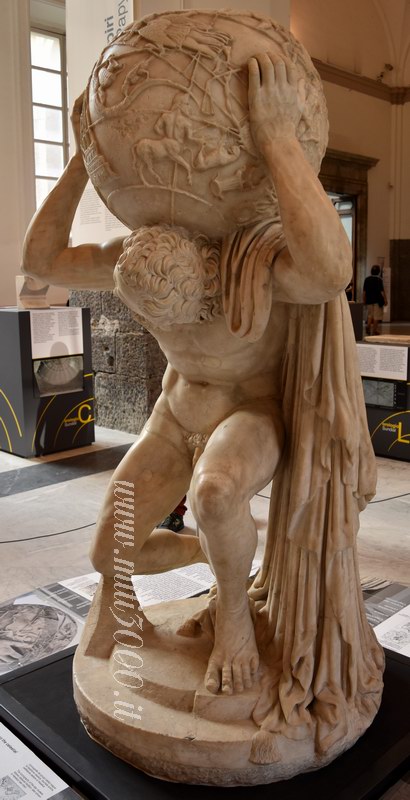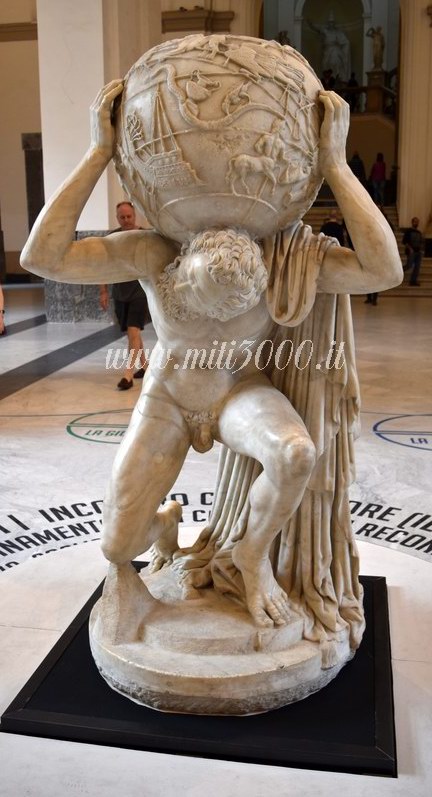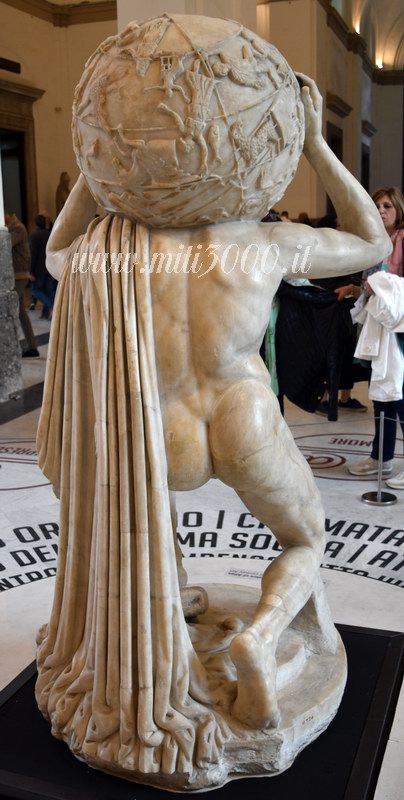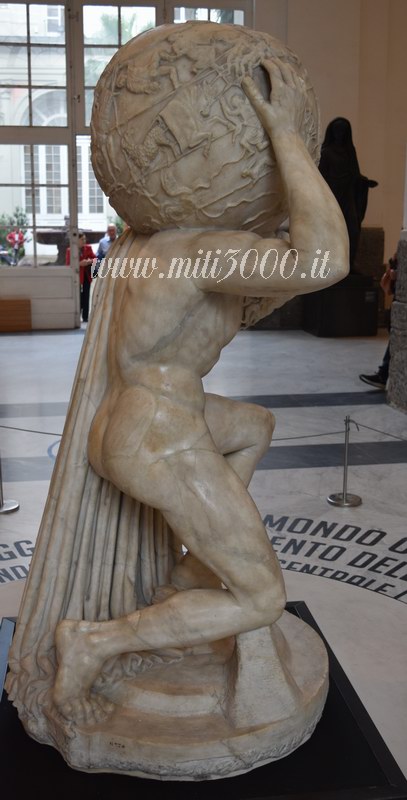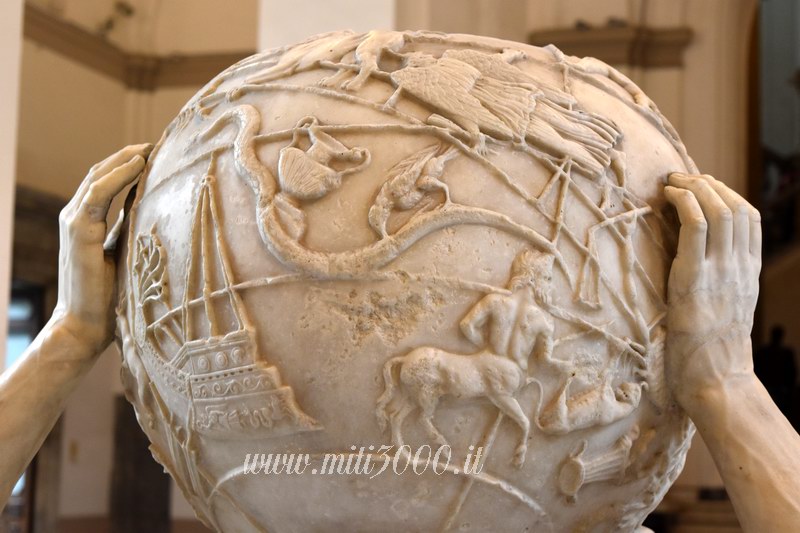Testo
L’Atlante Farnese e la rappresentazione della sfera celeste, Inv 6374
L’Atlante Farnese è così denominato per l’appartenenza alla omonima collezione romana, trasferita a Napoli nel 1734 da Carlo di Borbone. L’interesse che storicamente ha suscitato è dovuto principalmente alla dettagliata rappresentazione delle geometrie basilari del sistema cosmologico geocentrico sulla sfera celeste che il titano porta sulle spalle, testimonianza di un elevato grado di conoscenze astronomiche raggiunto in epoca ellenistica.
The Farnese Atlas and the representation of the celestial sphere, Inv 6374
The Farnese Atlas owes its name to the fact that it belonged to the Farnese collection in Rome, which was transferred to Naples in 1734 by Charles VII. The interest it has attracted over the ages is mainly due to the detailed representation of the basic geometry of the geocentric cosmological model of the celestial sphere, carried by Atlas on his shoulders, reflecting the high level of astronomical knowledge achieved in the Hellenistic age.
Le costellazioni
Le costellazioni sono correttamente collocate in rapporto ai circoli astronomici: Drago, Cèfeo, Boote, Corona Boreale, Ercole, Lira, Cigno, Cassiopea, Perseo, Auriga, Ofiuco, Serpenti, Aquila, Delfino, Pegaso, Andromeda, Balena, Orione, Eridano, Lepre, Cane maggiore, Argo, Idra, Cratere, Corvo, Centauro, Lupo, Altare e Corona australe. Lungo la fascia dell’eclittica solare troviamo invece le costellazioni dello Zodiaco: Ariete, Toro, Gemelli, Cancro, Leone, Vergine, Bilancia, Scorpione, Sagittario, Capricorno, Acquario, Pesci.
The constellations
The constellations are correctly positioned in relation to the astronomical circles: Draco, Cepheus, Boótes, Corona Borealis, Hercules, Lyra, Cygnus, Cassiopeia, Perseus, Auriga, Ophiuchus, Serpens, Aquila, Delphinus, Pegasus, Andromeda, Cetus, Orion, Eridanus, Lepus, Canis Major, Argo, Hydra, Crater, Corvus, Centaur, Lupus, Ara and Corona Australis. Along the band of the ecliptic there are the constellations of the Zodiac: Aries, Taurus, Gemmi, Cancer, Leo, Virgo, Scorpius, Sagittarius, Capricorn, Aquarius and Pisces.
La precessione degli equinozi
L’attrazione del Sole e della Luna fa oscillare l’asse terrestre portando a un lento spostamento delle stelle sulla sfera celeste. Secondo i Caldei (2500 a.C. circa), la costellazione dell’Ariete coincideva con il punto g del coluro equinoziale (Est) all’equinozio di primavera; ai solstizio d’estate, invece, la costellazione del Cancro si trovava all’intersezione tra l’omonimo tropico, il coluro solstiziale e l’eclittica. Tali corrispondenze si sono perse nei secoli per effetto della precessione; sul Globo Farnese l’intersezione tra l’eclittica e il Tropico del Cancro avviene in prossimità dei Gemelli, condizione realmente avvenuta nel II secolo d. C. (il 129 d.c. è la probabile datazione dell’Atlante). Lo scultore ha registrato nella pietra una testimonianza delle osservazioni astronomiche possibili in quegli anni.
The precession of the equinoxes
The attraction of the Sun and the Moon causes the Earth’s axis to oscillate, leading to a slight shift of the stars on the celestial sphere. According to the Chaldaeans (c. 2500 BC), the constellation of Aries coincided with the point g of the equinoctial colure (East) at the spring equinox; instead, at the summer solstice, the constellation of Cancer was to be found at the intersection between the Tropic of Cancer, the solstitial colure and the ecliptic. These correspondences have been lost over the centuries due to the effect of precession; on the Farnese globe the intersection between the ecliptic and the Tropic of Cancer occurs near Gemini, which actually took place in the second century AD (the Atlas probably dates to 129 AD). The sculptor recorded in stone evidence of possible astronomical observations made during this period.
Meridiani e paralleli lungo la sfera celeste dell’Atlante
Sul globo marmoreo troviamo incisi il Tropico del Cancro (emisfero boreale) e il Tropico del Capricorno (emisfero australe), l’equatore celeste e i due circoli polari, tutti paralleli tra di loro. L’eclittica solare (percorso annuale apparente del Sole lungo la sfera celeste) è inclinata di un angolo di circa 24° rispetto all’equatore celeste; altre due curve ad essa parallele definiscono la fascia eclittica, dell’ampiezza angolare di circa 16°, nella quale sono raffigurate le dodici costellazioni zodiacali. Sulla sfera sono incisi anche due meridiani, il coluro equinoziale (passante per i punti cardinali Est e Ovest e per i Poli) e quello solstiziale (passante per i punti cardinali Nord e Sud e per i Poli).
Meridians and parallels along the celestial sphere of the Atlas
The marble globe is engraved with the Tropic of Cancer (northern hemisphere) and the Tropic of Capricorn (southern hemisphere), the celestial equator and the two polar circles, all parallel to each other. The ecliptic (the apparent annual path of the Sun across the sky) is inclined at an angle of about 24° with respect to the celestial equator, two other curves parallel to it define the ecliptical band, with an angular width of about 16°, within which the twelve constellations of the zodiac are portrayed. The sphere is also engraved with two meridians, the equinoctial colure (passing through the cardinal points east and west and through the poles) and the solstitial colure (passing through the cardinal points north and south and through the poles).

